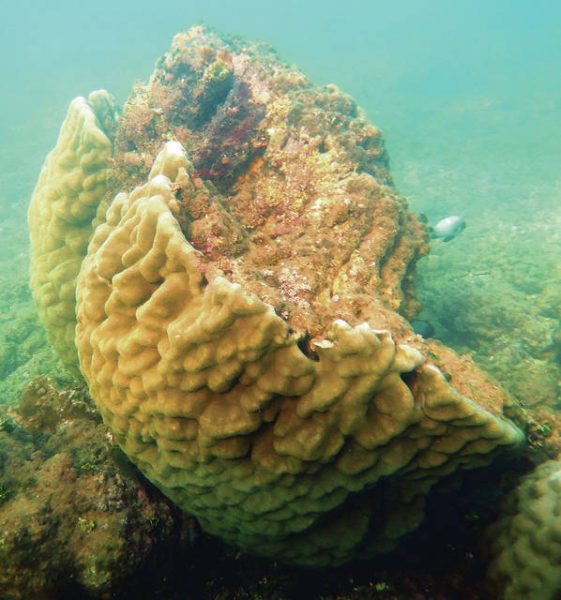Published in the Ocean Watch column, Honolulu Star-Advertiser © Susan Scott
April 20, 2019
The North Shore surf was so high the past two months that I couldn’t snorkel safely in my favorite spot. But last week, the ocean finally laid down and I got in the water. And got lost.
Not lost lost. But after snorkeling in that area for 25 years, I know the location of nearly every rock, coral head and World War II structure there. That morning, though, I couldn’t get oriented.
I soon spotted the problem. The enormous waves had bowled over my old friend, a healthy, two-humped coral head about 3 feet tall and 4 feet wide that I used as a marker. The surf had also scattered rocks, rearranged sand and scoured off seaweed. The oceanscape I knew so well had changed.
 Porites lobata, or lobe coral
Porites lobata, or lobe coral
— called pohaku puna in Hawaiian —
is Hawaii’s most common kind of massive coral.
©2019 Susan Scott
The tiny species that built my lumpy coral fortress is Porites lobata, or lobe coral. Called pohaku puna in Hawaiian, this is Hawaii’s most common kind of massive coral. Some mounds grow to 10 feet high and can be more than 20 feet in diameter.
The creatures expand their castles about one-third of an inch in height per year, making my colony probably 100 years old or older.
Lobe coral is easy to identify when it grows in its common form of rounded hills and is its usual color of tan or lime green. But when ocean currents, other marine species and varied topography enter the picture, lobe coral can trick us, growing in fingerlike spires or encrusting patches. It can also host algae that turn the transparent creatures that build the structures brilliant shades of blue and purple.
The species is found throughout the Indian and Pacific oceans, from tide pools to depths of up to 150 feet. And although lobe coral often appears in massive forms, only the outermost 1 millimeter is alive. (A millimeter is about as small as the naked eye can see.)
A fragile skin-like outer layer connects all the living corals in a colony, allowing individuals to share food. That’s why we should never kick or grab hold of coral heads.
Coral heads consist of thousands of individuals, all descendants of a single founder. When conditions are right, a drifting jellylike coral attaches itself to something hard on the sea floor. Once settled, the animal builds itself a protective limestone cup to live in. If all goes well, the founder clones itself, the clones clone and on and on it goes, building its fortress one tiny bit at a time.
Examining my tipped over coral head allowed me to appreciate its massive limestone base. Each little creature contributes to the building of these weighty rocks by periodically lifting itself off its cup’s hard floor, and secreting a new floor above the old one.
In this way, a coral colony grows up and out, leaving its former calcium carbonate cups below the current ones.
My camel-humped coral head took a beating, but I know that the creatures still alive in it are already cloning their way up the sides to bask in the sunlight.
My snorkeling signpost may have taken a tumble, but it lives on to guide me.